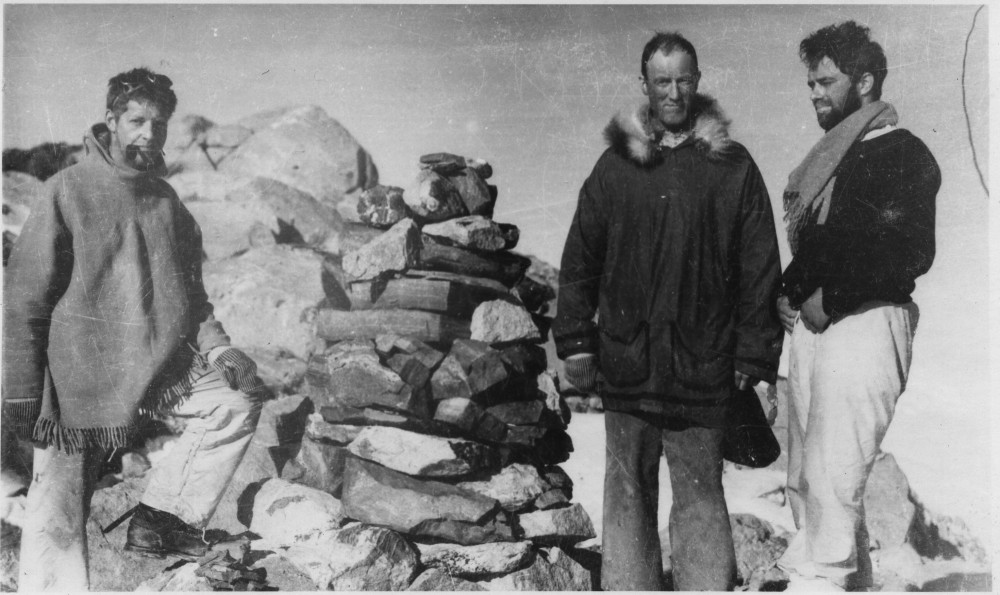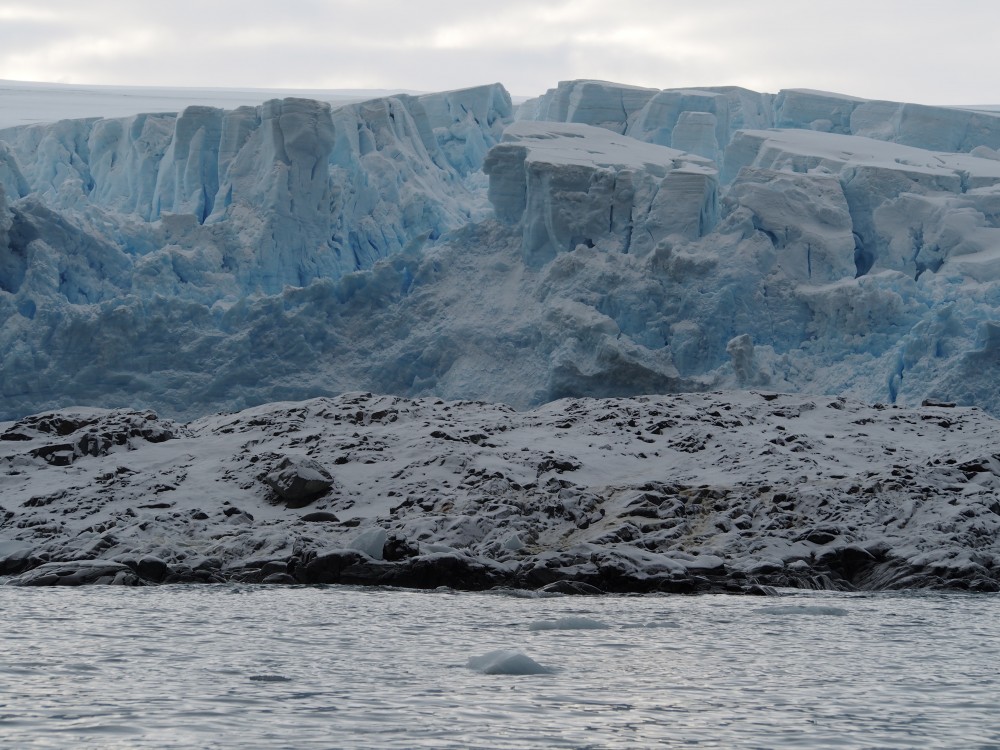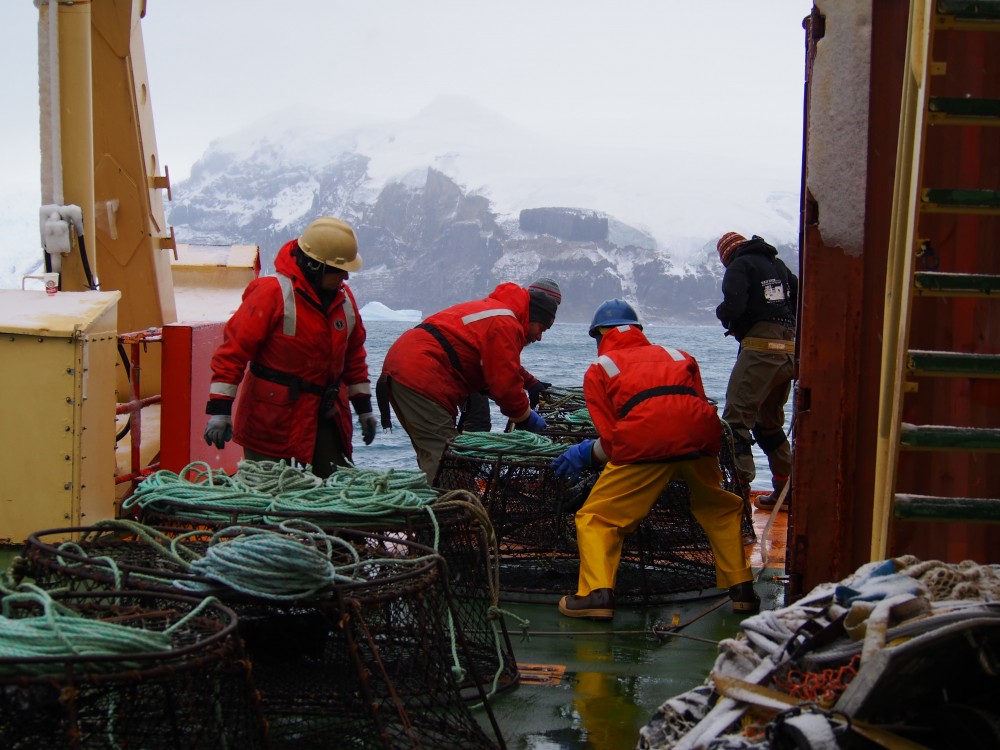Landing Page
Special Projects
This story is part of a series of specially designed stories that represents some of the best journalism The Post has to offer. Check out the rest of the special projects here.


Megan Knapp
3/7/2019
To get to Antarctica, researchers fly to Punta Arenas, Chile, near the tip of South America. From there, they take a five-day ship ride to the western peninsula of Antarctica, where they spend the next two to four months. One OU researcher has been on the trip several times.
Lisa Crockett has been studying in Antarctic since 1980. She is a professor of biological sciences at Ohio University studying the physical attributes that determine how Antarctic ice fish cope with their environment.
The trip to the Antarctic can be challenging, but Crockett has experienced it several times.
“It is a pretty hellish five days,”Elizabeth Evans, one of Crockett’s graduate students, said.

Provided via "Cold" by Laurence Gould
Freddie Crockett, Eddie Goodale and Norman Vaughan at Amundsen's Cairn
People are thrown from their bunks and someone even broke their pelvis while on board.
“Everyone gets very seasick,” Evans said. “I am especially known for my poor stomach while at sea.”
Going at about 11 knots, or 13 mph, the ship that takes the team to and from Antarctica is the R/V Laurence M. Gould, which is named after the explorer of the same name.
“Forty years ago, once in a blue moon, you could hear the glacier crack, but now it is about every 15 minutes.”Lisa Crockett
When travelling to the Antarctic, the research team begins fishing to have a supply of specimen before beginning their research.
They also looking at how the warming of the water, because of climate change, is affecting the fish.
“Forty years ago, once in a blue moon, you could hear the glacier crack, but now it is about every 15 minutes,” Crockett said.
During the period closest to the winter solstice, around June 22, the sun officially rises at about noon and sets at about 3:00 p.m., Amanda Biederman, one of Crockett’s graduate students, said.
They see beautiful sunrises and sunsets that lasted for long periods of time, sometimes up to an hour.
While on the Laurence M. Gould, the research team usually works 12-hour shifts in teams of two, Evans said. In one fishnet, they can get anywhere between zero and 12 fish.
Once the ship arrives at Palmer Station, one of the three Antarctic stations the U.S. supports year-round, the science begins.
Palmer Station houses about 40 scientists and support staff, Crockett said. In comparison, McMurdo Station, the biggest U.S. Antarctic station, houses about 1000 people.
Everyone who deploys to Antarctica must pass a stringent physical and medical examination since they work far from medical care that is typical in the United States, Peter West, the manager of the Polar Outreach Program, said.
Every time Crockett sails to Antarctica, she is reminded of her father as she sits aboard the Laurence M. Gould, a ship that has connections with her father’s expedition. He had trained for about a year to become a dogsled driver, Crockett said.
Gould was second in command during Adm. Richard E. Byrd’s expedition to the Antarctic in 1928— with Crockett’s father, Freddie, as a dogsled driver. Freddie went to the Antarctic when he was a first-year college student. He heard Byrd was organizing an expedition and thought, “sign me up.”
Crockett thinks her father was using the opportunity as an excuse to leave school. Crockett knew she wanted to see the place that influenced her father so much throughout his life.
Crockett heard stories about the Antarctic from her father while she was growing up. Little did she know she would be there one day.
When Crockett’s father, Freddie Crockett, died in 1978 she was at a crossroads. She hadn’t attended college at the age most students do and wasn’t sure what her next step would be, but she knew she wanted to experience what her father had.
She was hired by a support contractor that helps the National Science Foundation in 1980 to go to Antarctica, at a similar age to when her father went. She did this for about two years and was then hired at the University of Illinois working on how ice fish survive in the freezing waters, Crockett said.
At that time, Crockett still didn’t have a college diploma, but because the University of Illinois needed employees with Antarctic experience, she was hired to help collect fish.
After doing that for a couple years, Crockett went to college, received her bachelor’s in zoology and then attended the University of Maine for her doctorate.

PROVIDED via Lisa Crockett
Signs of glacial retreat.
The main reason Crockett chose the University of Maine was because a faculty member, Bruce Sidell, just received his first grant for Antarctic research. Sidell became her advisor, which allowed her to pursue what was becoming her passion: Antarctic ice fish.
Crockett describes her research partner, Kristin O’Brien, as her “academic sibling” because she also had Sidell as her adviser. O’Brien is a professor at the University of Alaska Fairbanks. O’Brien attended a talk about the research Sidell and Crockett worked on and found it combined many areas in which she was interested, so she attended the University of Maine too, O’Brien said.
Crockett and O’Brien began studying in the Antarctic together in 2009. At that time, it had been 18 years since Crockett had been—and she was yearning to return.
Crockett has received three grant cycles for her current research, allowing her to go to the Antarctic five times to research the thermotolerance of Antarctic fish, which are the evolutions they have made to be able to survive the extremely cold environment, Biederman said. Crockett’s lab has not received a grant for the 2019 field season. Her most recent grant from the National Science Foundation was for $492,672, West said in an email.
When Crockett began working in Antarctica in the ‘80s the research field season was in March, but it isn’t cold enough anymore, so the field season is now in the Antarctic winter, between June and September, Crockett said. Palmer Station is just north of the Antarctic Circle, so there is usually only about five hours of sunlight per day.
Palmer Station is also on a peninsula of Antarctica, which means the temperature is heavily influenced by the ocean and isn’t nearly as cold as it is inland, Crockett said.
The coldest temperature Crockett ever experienced in the winter was about 14 degrees Fahrenheit. In the summer the temperature can get above freezing. Wind speed can get as high as 80 mph. Biederman said, at times, it felt like the wind could blow someone away while on the ship.
Once the ship arrives in Antarctica, the team begins studying the specimen they have collected.
Ice fish evolved with unique characteristics because of the Antarctic Circumpolar Current, which is a massive, slow-moving body of water that surrounds Antarctica, Biederman said. This has allowed ice fish to evolve in a relatively isolated area from the rest of the world’s oceans.
An outstanding difference is the loss of hemoglobin in the blood of ice fish. Ice fish are the only known vertebrates on the planet to lack hemoglobin.
Hemoglobin is an oxygen-binding protein that, for fish, binds oxygen at the gills and transports oxygen to the body, O’Brien said. Hemoglobin is also the pigment that makes blood red, so ice fish have clear blood. Red-blooded fish have about a 90-percent higher capacity to carry oxygen than ice fish.
Ice fish are able to live without hemoglobin because the water they live in is so cold, at about 28.68 degrees Fahrenheit. The water is so oxygen-rich that they do not need it, Biederman said. Another reason ice fish do not require hemoglobin is that their metabolic rates are so low, their oxygen demands are not as high.
Crockett’s and O’Brien’s research is focused around the thermotolerance of Antarctic fish as well as their capacity to survive as the climate warms, O’Brien said. The temperature of the region of Antarctica they have been working in has increased more than anywhere else, Crockett said.
There is data suggesting ice fish experience some cardiac failure at warmer temperatures, Crockett said. There is also data supporting the idea that there may be neuronal failure. The lab is trying to determine the exact changes, and how much the fish can take before dying.
The research team uses two techniques to test the capacity of these animals to survive as the climate warms. The first is an acute increase in temperature, which is when fish are put in circulating seawater tanks and then the temperature is rapidly increased, O’Brien said.

PROVIDED via Lisa Crockett
Pushing fishing pots off the stern of the ARSV Laurence M. Gould in Dallmann Bay, Antarctica
The second type of experiment is a warm acclimation experiment which is where the fish are put in another tank and then the temperature is gradually increased for six-to-ten weeks, O’Brien said.
Because it has salt in it, seawater freezes at 28.58 degrees Fahrenheit, which is the temperature that the ice fish are living in. For acclimation experiments, the water temperature is increased to 41 degrees Fahrenheit.
Crockett’s lab is focused on specifically studying the membranes that governs thermotolerance in Antarctic fish, Biederman said. O’Brien’s lab is primarily looking at bioenergetics and the impact on the mitochondria. Both labs also work on how the cardiovascular system is affected by climate change.
In order for ice fish to survive climate change they require a combination of factors. The first is thermal plasticity, which is how well animals are able to adapt to temperature changes in their environment. The second is adaptive capacity, which is looking at how much variation there is in the genome at the population level, O’Brien said. The higher the variation, the likelier the ice fish are able to evolve to handle the changing climate.
There isn’t much downtime while researching in Antarctica because the team has a strict time table, but on days when it allows, there is plenty to do. Crockett particularly enjoys cross-country skiing. However, there has not been much snow in the recent field seasons, Crockett said.
Workers don’t have to worry about food, as there is something called the “Palmer 15” which is similar to the “freshman 15.” At least one, and sometimes two, chefs are on station, Crockett said.
Palmer Station also has darts, pool, ping pong and a gym, Crockett said. There is even a hot tub, which is actually just a fish tank that has been repurposed.
When O’Brien was asked about her favorite part about being in Antarctica, she said, laughing, “other than being with Lisa? That is one of my favorite parts.”
BackLanding Page
This story is part of a series of specially designed stories that represents some of the best journalism The Post has to offer. Check out the rest of the special projects here.